- Author Arianna Cook [email protected].
- Public 2024-01-12 17:55.
- Last modified 2025-06-01 07:38.
Characteristics of the cornflower plant, growing in the open field, methods of reproduction, how to get rid of diseases and pests, a memo to a florist, species.
Cornflower (Centaurea) belongs to the plants that are part of the Asteraceae family. It is sometimes referred to as Composite. Most of the species included in this genus of herbaceous flora are distributed in the southern European territory, preferring to grow among different crops. For some reason they especially liked rye. The entire growing area falls on the northern hemisphere of the planet. According to some estimates, the genus contains up to 500 varieties of cornflowers.
| Family name | Astral or Compositae |
| Life cycle | One-year or two-year |
| Growth features | Herbaceous |
| Reproduction | Seed and vegetative (division of the rhizome) |
| Landing period in open ground | Delenki, planted in August-September or spring |
| Disembarkation scheme | At a distance of 45-50 cm |
| Substrate | Light loamy |
| Illumination | Sunny place or partial shade |
| Moisture indicators | Watering is moderate, waterlogging is harmful |
| Special Requirements | Unpretentious |
| Plant height | 0.5-0.8 m |
| Color of flowers | snow-white, blue, yellow, pinkish, purple, red, burgundy, blue |
| Type of flowers, inflorescences | Baskets |
| Flowering time | June-November |
| Decorative time | Summer-autumn |
| Place of application | Flower beds, flower beds, lawns |
| USDA zone | 4-9 |
Basically, cornflowers are a plant with a one-year or two-year life cycle. It is curious that different species differ in different types of root systems. Some are characterized by an elongated rhizome with branches (like the soft cornflower - Centaurea mollis), others - by a large number of root processes (for example, Fisher's cornflower - Centaurea fischeri). There are species in which one root has a core that goes deep into the soil (in the Russian cornflower - Centaurea ruthenica). Other varieties are owners of a rather thick rhizome. The plant owes its name in Latin to Karl Linnaeus, the famous taxonomy of the flora and fauna of the planet, who, choosing the name of the flower, relied on ancient Greek myth. This legend said that with the help of a flower, the celebrated centaur Chiron was able to heal himself from the poison released by the Lyrnean hydra. Therefore, Linnaeus chose the term "centaurea" for him, which comes from the word "centaureus" - "referring to the centaurs." According to another version, the name came from the merger of the Greek words "kewtwe" and "tavros", translated as "stabbing" and "bull", that is, "stabbing bulls." People can often hear how these plants are called blue flowers, blues, hairs.
Their stem is straight, branched, reaches 50-80 cm in height. However, there are species in which stems grow creeping along the surface of the ground. On the shoots, leaf plates with simple or dissected (feathery) outlines unfold. Often there is pubescence, because of it the foliage looks silvery. Perennial species of cornflower are distinguished by the peculiarity in which the leaves growing in the root zone do not change color (and they have it green) all year round. Usually, the growth of such leaf plates is divided into two periods: spring - the unfolding of young foliage, which ends its life with the arrival of autumn, autumn, falling in September-October, when leaves appear, surviving until the next spring days.
During flowering, flowers are formed, collected in a basket inflorescence. They are funnel-shaped along the edge and tubular in the middle. The color of the petals can be snow-white, blue, yellow, pinkish, purple, red, burgundy or blue. The flowering process stretches from the beginning of summer, often to November (approximately 45 days).
Since a plant without transplants can grow well in one place for up to a decade, it serves as an ornament to any flower bed, flower garden or lawn. The blue tones of flowers are combined with bright red poppies, yellow inflorescences of escholtia and calendula, and bright cosmos will also be wonderful neighbors.
Growing cornflower in the open field, planting and caring for flowers
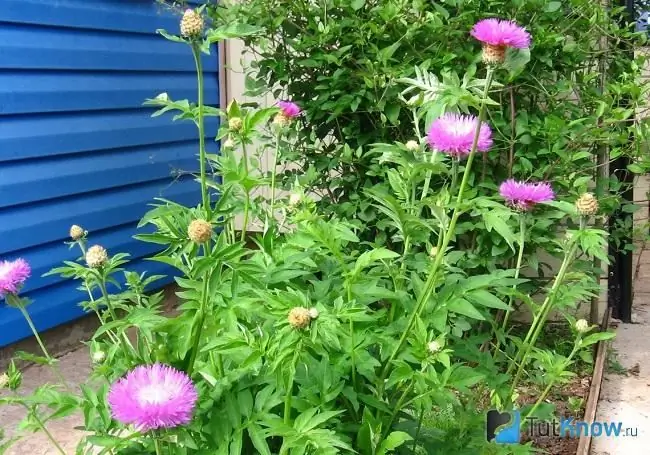
- Landing place blue flowers choose sunny, although a flower bed with a slight shade, which will give the crowns of trees or fences, may be suitable. But flower growers recommend choosing a place for annual species right away, taking into account these requirements, since transplanting negatively affects the plants. The flower bed should be spacious so that the planted cornflower bushes do not shade each other.
- Landing. Annuals must be propagated directly by planting seed in the ground in early spring. After that, thinning is needed so that young cornflowers develop normally. Seedlings are left at a distance of 15-20 cm from each other. Perennials can also be propagated by seeds, but the division of the bush and cuttings are generally accepted. If the reproduction is seed, it is better to sow seeds in open ground before winter. In this case, the seedlings will appear in a few days, but they will need to be covered with fallen dry leaves. Delenki of such cornflowers are planted at the end of spring, having previously prepared the soil (fertilizing it). The distance between the seedlings should be 45-50 cm. The plant is placed in a hole, its roots are straightened, sprinkled with earth and then squeezed. Planting is carried out so that the new bud is not buried, but is located flush with the substrate. Freshly planted young cornflowers will require abundant watering.
- Soil for planting. Light loam is most suitable for growing cornflowers. The acidity of the substrate should be neutral (with a pH of 6, 5-7) and sufficient looseness should be ensured. If the soil is acidic, then it will be necessary to lime it, when a layer of limestone or dolomite flour, which is almost 1 cm, is distributed on its surface. When the soil is clayey on the site, river sand will help to lighten it.
- Watering for cornflowers, a moderate one is needed, since in plants when the soil is flooded, the root system can begin to rot. Usually, the hairs have enough natural precipitation in the summer, but if the weather is dry and hot, it is recommended to water the flower beds with these flowers a little. After moistening the soil, it is loosened, weeds are weeded and mulched with compost.
- Fertilizer hairs allows you to extend the flowering process, this operation is performed twice a month. It is necessary to use complex mineral preparations (for example, Kemiru-Universal), 20-30 g per m2. It is important here to maintain a balance and not use more fertilizing than required, otherwise the foliage will inevitably begin to turn yellow. If perennial varieties are grown, then with the arrival of autumn they need to be fed again in order to increase the resistance of plants in winter.
- Pruning cornflowers. It is important to remove discolored flowers during the flowering process, otherwise the blue will multiply by self-seeding, and the planting will become unaesthetic. There are two methods of cutting: high, when the stems are cut immediately below the inflorescences, and low, when the stems are left only 10 cm from the ground. The first method is often used so that no bald spots are left on the flower bed.
Cornflower breeding methods
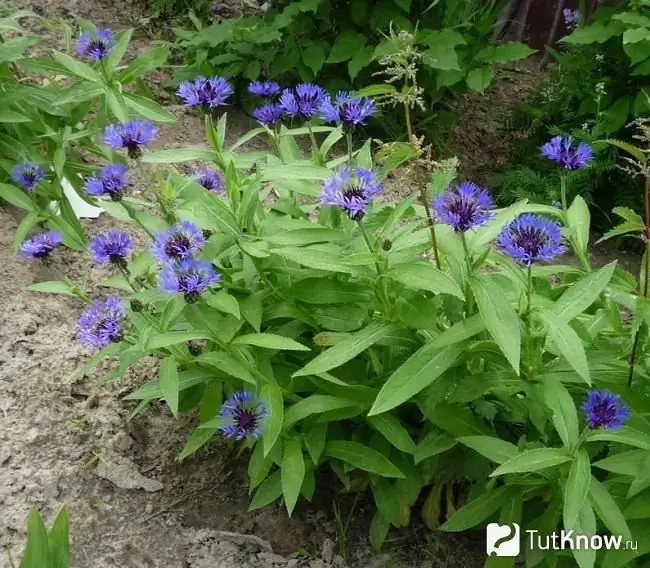
Both vegetative (dividing) and seed methods of obtaining new blueberries are suitable.
If the species is perennial, then it is preferable to propagate it in the spring or at the end of summer. The selected bush is carefully removed from the soil, shaken off the remnants of the soil from the roots and put in a basin of water to soak. Ground shoots are cut and cut off a little from the part located on the periphery of the bush. When dividing, they try to have three renewal buds on the divisions. Planting is carried out immediately after separation so that the root system does not dry out. After that, the aboveground part is cut off so that no more than 10 cm remains of it. Watering the planted cornflowers will require 3-4 watering times per month until the plants take root. Flowering can only be expected next summer.
Reproduction directly depends on the structure of the root system. If we talk about the type of cornflower mountainous and soft, then reproduction can be carried out by cutting off parts from the rhizome, but the point of renewal should be well developed on the segment. Fischer's cornflower reproduces successfully using root suckers. Reproduction using divisions with a rhizome segment is applicable for varieties of whitewashed cornflower, Phrygian and large-headed. Since the species of blue, Russian and musky cornflower have an elongated taproot, transplants are contraindicated for it. Since such plants practically do not take root, you can propagate them by cuttings.
Seeds are sown before winter so that the planting material undergoes natural stratification, seedlings will appear immediately after the snow cover melts. You can also sow seeds in April-May, when the soil warms up thoroughly. And then a week later, young shoots of cornflower become visible. The seedlings are thinned out so that the distance between the plants is 15-20 cm. It is important to choose a place right away so as not to transplant flowers.
Fight against possible diseases and pests of cornflower

Florists appreciated cornflowers for their resistance to diseases, but if trouble happens, then you should pay attention to care, since usually all problems begin due to waterlogging of the soil. If the foliage of annual cornflowers began to become covered with dark spots, then this is a consequence of fusarium and will need to be treated with Fundazol. Experts recommend periodically spraying with a three-day infusion of cow dung, which is diluted in water in a 1: 1 ratio. If pests appear (spider mites or aphids), then you can use ash, which will also be good for diseases. She is usually sprinkled with foliage and stems of cornflowers
When problems have arisen in perennial species of hairs, it is recommended to cut off all parts that have been affected and burn them so that the infection does not spread around the garden, the problem will be stopped next year.
Memo to the florist about Vasilka: application in medicine

It is curious that cornflower is not only decorative and pleasing to the eye. Leaf plates are successfully used as a seasoning for preserving meat products, as they possess such aromas that resemble mint, cloves and lemon. Culinary specialists who prepare pates, canned food, sausages also know about these aromatic qualities of cornflower foliage, which are often used for salting. They also note that cornflowers are excellent suppliers of nectar for bees.
If we talk about medicinal properties, then here we will talk about a variety of blue cornflower (Centaurea cyanus), since its flowers have diuretic properties and are recommended to be used for edema that occurs with kidney diseases. Also known for their ability to reduce fever, fight microbes, diaphoretic and choleretic action. Cornflower leaves have the ability to relax the body, quickly heal wounds and relieve pain. Therefore, it is prescribed to take infusions and decoctions based on this plant to relieve spasms of smooth muscles that affect internal organs, improve digestive processes and stimulate appetite. Such funds also help with colds, coughs, heart edema and nephritis.
If there are eye problems, then for a long time healers used lotions and compresses made on blue cornflower, these same drugs helped with skin diseases. Healers were also prescribed to take funds from this plant to get rid of worms and colic, they also relieve headaches, manifestations of jaundice and fever, while it was known for a long time about the ability to purify the blood.
With painful sensations in the joints, you can prepare decoctions and add them to the water while taking a bath. Due to its wound healing properties, blue cornflower extract is used in cosmetology. So, the prepared lotion is recommended to be used to cleanse not only oily, but also problem skin, since the pores are narrowed and the skin is saturated with useful substances. If the extract is added to hair care products, then growth is activated, since the hair begins to fill with the necessary nutrition along its entire length, and this also has a positive effect on the scalp.
When in the old days the hostesses wanted to give Easter eggs a blue hue, then blue cornflower flowers were used as a dye.
Types of cornflowers
Annual varieties:
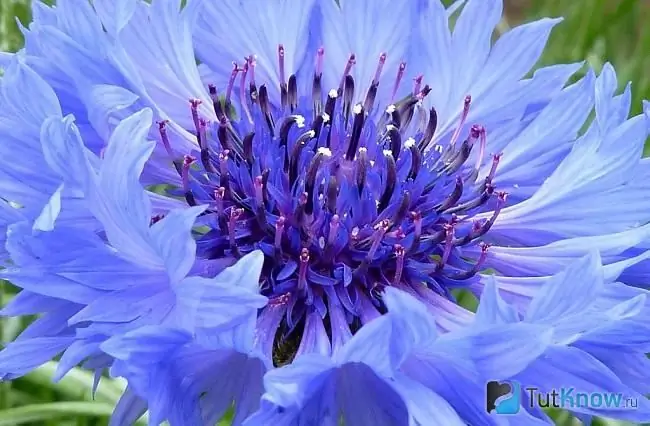
Blue cornflower (Centaurea cyanus)
occurs under the names Blue cornflower or Field cornflower … It can be both an annual and the owner of a two-year life cycle. The erect stem reaches a height of 80 cm. The foliage has a grayish-green tint, the leaves grow in the next order, their form is spider-woolly. The leaves in the root zone have petioles, all the rest are devoid of them and grow sessile, differ in linear outlines, along the edge of the whole Inflorescences have a bright blue color and represent the final single baskets, in the part where they are located, the stem is devoid of leaves. The flowering process is from June to late autumn days.
The blue cornflower has become the basis for breeding plants, which are distinguished by their short stature (the height of their stems does not exceed 30 cm) and inflorescences of very bright colors. There are also terry forms, which were obtained thanks to the efforts of breeders, differing in the most diverse shades of flowers:
- Plena Azurea petals of flowers of a pale blue color;
- Plena rosea a plant with pink inflorescences;
- Plena carminea has red petals;
- Black bal differs in flowers of a rich brown hue;
- Blue diadem flowers, connected baskets had a rich blue tone;
- Florence pink a plant with compact size, the stems of which are crowned with pink inflorescences.
Perennial varieties:

Mountain cornflower (Centaurea montana)
… The most common variety. The height of the bush does not exceed 40 cm. Flowers open in the first days of summer. The color of the petals is blue. There are varieties that are directly related to the color of flowers: Alba (snow white), Rosea (pink), Violetta (purple). Such a variety as Grandiflora inflorescences consist of bright blue flowers, Parham flaunts with lavender-crimson tones.
Beautiful cornflower (Centaurea pulcherrima)
… Stems reach 0.4 m in height. The foliage is quite decorative because of the silvery pubescence, as if its surface is covered with a whitish cobweb. From June to July, pink flowers open on the stems.
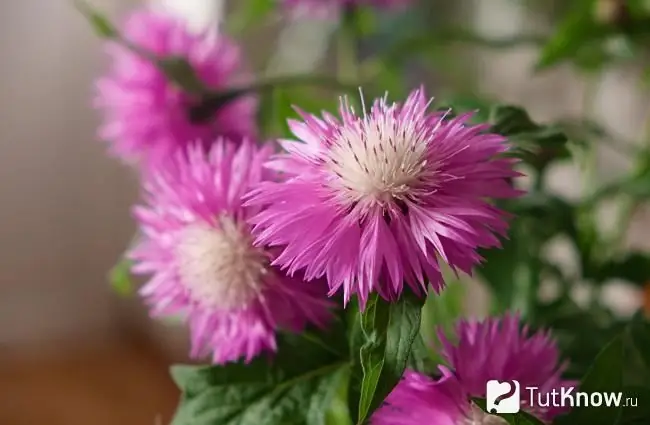
Whitewashed cornflower (Centaurea dealbata)
The foliage has an unusual color - whitish due to pubescence on the surface. The height of the stem does not exceed 0.8 m. The color of the flowers is pinkish with a snow-white center. The flowering process takes place throughout the summer. Interesting varietal form Steenbergii possessing carmine-purple inflorescences.
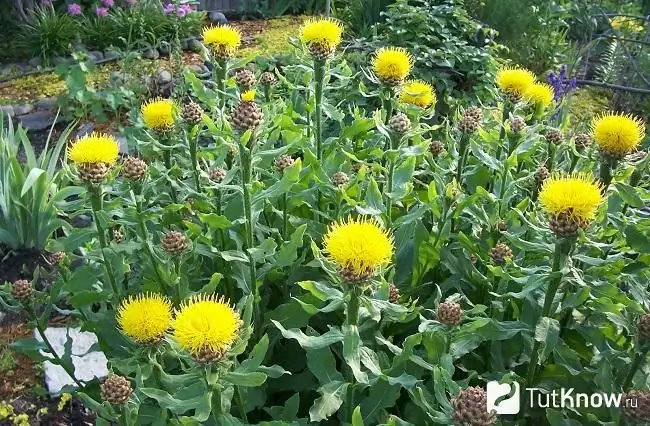
Large-headed cornflower (Centaurea macrocephala)
can reach stems up to meter indicators. From the name it is clear that the buds are large, and with the arrival of summer they open in inflorescences made up of bright yellow flowers.
Video about cornflower:








